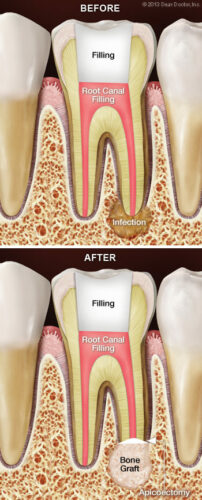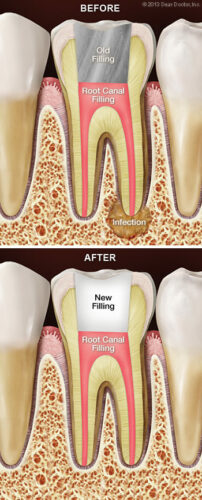Endodontist in Parma, OH
Endodontics: Treatment for Infected Nerves
Endodontics is the dental specialty focused on the nerves of the teeth. Root canal therapy is the most well-known and common procedure in this field. When a tooth becomes infected, it often involves the nerves within the root. If the infection is not treated, it can lead to more serious complications, such as an abscess, which may result in bone loss in the jaw.
Root Canal Procedure
During a root canal procedure, the infected nerves are removed to prevent further damage. The dentist begins by numbing the area around the tooth with a local anesthetic. Then, they will drill into the tooth to create an opening into the canal where the infected nerve tissue resides. The canal is carefully cleaned, disinfected, and sealed to restore the tooth to its original function and prevent further infection.

Root Canal Procedure: Steps and Aftercare
Once the dentist has accessed the tooth’s canal, they will remove the infected tissue and thoroughly clean the area. After the infection has been cleared, the space is filled with a sealant known as gutta percha, which helps to prevent further infection.
It is highly recommended that a tooth that has undergone a root canal be fitted with a crown. This not only enhances the tooth’s appearance but also increases the likelihood of a successful outcome for the root canal. Despite the negative reputation, the term “root canal” has become less daunting due to advances in dental technology, making the procedure much more comfortable.
Thanks to local anesthetics and pain management, most patients experience little to no discomfort during the procedure. While some soreness is normal after a root canal, it usually subsides quickly. Over-the-counter pain relievers are typically sufficient to manage any discomfort, although your dentist may prescribe stronger medication if needed. The root canal procedure will also relieve pain caused by infection, allowing you to eat and drink without discomfort from hot, cold, or biting pressures.
If you’re experiencing tooth pain, don’t hesitate to consult your dentist to discuss if a root canal might be the right solution for you.
Other Services

Apicoectomy: Procedure and Aftercare
An apicoectomy is performed when a root canal has not been successful in fully resolving an infection. When the infection persists or returns, this procedure is often necessary. Since there are multiple nerves within the tooth that may contain infected tissue, it can be challenging to ensure that all the infection is removed during a root canal.
During an apicoectomy, the tip of the tooth’s root is removed, and the space is filled with a sealing material to prevent further infection.
Typically, a second root canal is considered before an apicoectomy, as it is a simpler, less invasive procedure. For the apicoectomy itself, you will be given a local anesthetic to numb the area. The dentist will make an incision in the gum to access the root of the tooth. Any inflamed tissue will be removed to clean the area thoroughly.
The surgery is very precise, as only a few millimeters of the root are removed. Magnification and fine instruments are used to ensure a high rate of success for the procedure. After the root is removed, a filling is placed, and the gum tissue is sutured. Depending on the type of sutures used, you may need to return in a few days to have them removed, or dissolving sutures may be used instead.
Over the next few months, the bone will heal around the root, and the area will recover. If you’re experiencing persistent pain after a root canal, consult your dentist to see if an apicoectomy might be the right solution.

Root Canal Retreatment: Why It’s Needed
With proper care, most teeth that have undergone endodontic (root canal) treatment can last as long as natural teeth. Root canals performed by endodontists (root canal specialists) have a success rate of about 95%. However, in some cases, a tooth that received initial endodontic treatment may fail to heal, leading to persistent pain or disease months or even years after treatment.
Why Do I Need Retreatment?
While rare, a tooth may not heal as expected after root canal treatment for a variety of reasons:
- Narrow or curved canals may not have been treated during the initial procedure.
- Complicated canal anatomy could have gone undetected during the first procedure.
- The placement of the crown or other restoration may have been delayed after the endodontic treatment.
- The restoration did not adequately seal the tooth, allowing salivary contamination inside the tooth.
Additionally, a new problem may develop that threatens a tooth that was initially successfully treated. In such cases, retreatment is necessary to address these issues and preserve the tooth.
Root Canal Retreatment Procedure
New decay or damage to the tooth can cause the root canal filling material to become exposed to bacteria, leading to a new infection. A loose, cracked, or broken crown or filling can also expose the tooth to infection. Additionally, if the tooth sustains a fracture, retreatment may be necessary to save the tooth.
Root canal retreatment is typically performed in two visits and includes the following steps:
Initial Visit
During the initial visit, the endodontist will examine the tooth, take x-rays, and discuss your treatment options. If you and your endodontist decide to proceed with retreatment, the procedure will be scheduled for a future appointment.
Retreatment Appointment
On the day of the retreatment, the endodontist will administer a local anesthetic to numb the tooth. Once the tooth is numb, the endodontist will reopen the tooth to remove the root canal filling material. In some cases, complex restorative materials, such as crowns, posts, and core material, may need to be disassembled and removed to gain access to the root canals.
After removing the canal filling, the endodontist will clean the canals and carefully examine the inside of the tooth using a microscope, looking for any additional canals or unusual anatomy that may need treatment.
Once the canals are clean, the endodontist will refill and seal the canals, placing a temporary filling in the tooth. If necessary, post space will also be prepared at this time.
Post-Treatment Care
After retreatment, you will need to return to your dentist as soon as possible to have a new crown or restoration placed on the tooth to protect and restore its function.
If the canals are narrow or blocked, the endodontist may recommend endodontic surgery to address the issue.
